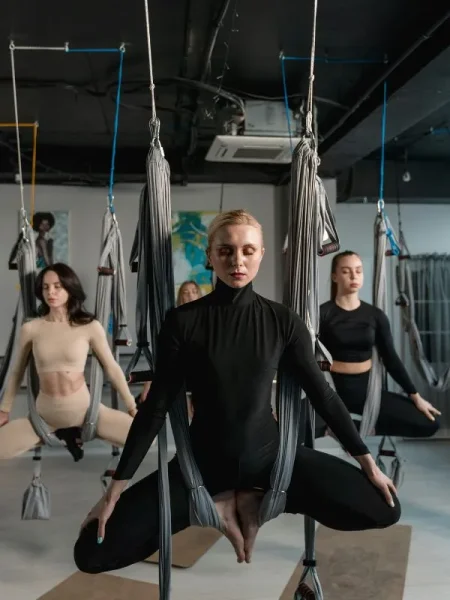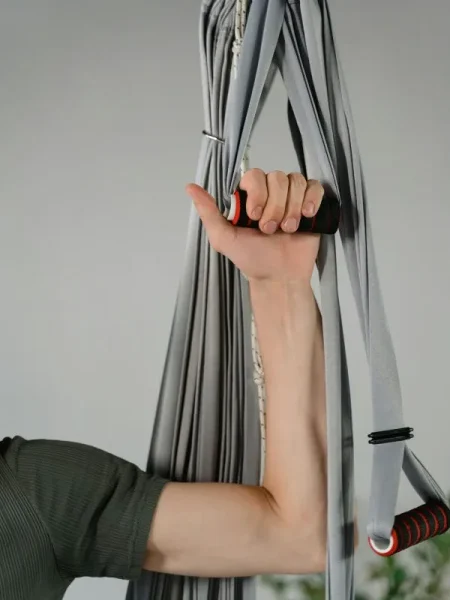Yoga Swing 101
Discover what they are, how they feel and why they are good for you
Yoga Swing
You’ve probably seen them on Instagram – those silky, hammock-like swings suspended from the ceiling, cradling someone mid-air as they strike a yoga pose that looks more like flight than fitness. And maybe you’ve wondered, “Is that for me?” Well, let’s talk about it. Because yoga swings – also known as yoga trapezes – aren’t just for bendy influencers or circus performers. They are for everyday folks too. People with stiff backs, tight hips, busy minds and everything in between.
Let’s break it down, from what a yoga swing actually is, to how it feels, why they are good for you and yes – how not to fall on your face.
What Exactly is a Yoga Swing?
It’s not a toy. Not quite a hammock. And definitely not as intimidating as it looks.
A yoga swing is a strong, flexible fabric apparatus – usually made from high-density nylon or silk – that hangs from a ceiling mount or sturdy bar. The fabric forms a kind of seat, often with additional handles or straps for extra support. Think of it as a supportive cocoon that lifts you just enough to give gravity a new role in your yoga practice.
Unlike a yoga mat, which keeps you grounded (literally), a yoga swing lets you work with gravity rather than against it. You stretch, balance, invert and even relax mid-air. And yes, it feels every bit as freeing as it sounds.
Why People Are Loving Yoga Swings – Not Just on Instagram
Here’s the thing: aerial yoga isn’t just “yoga, but make it floaty.” It’s a whole experience.
It relieves pressure on your spine
That gentle pull from the swing? It decompresses the spine, helping to create space between your vertebrae. If you’ve ever sat too long at a desk or woken up with a stiff back, that sensation can feel like a deep breath for your body.
It builds real strength
Think it’s all zen and swinging around? Not quite. Holding yourself up – even with help – activates your core, glutes and stabilizing muscles in ways a mat can’t always match. It’s sneaky strength-building, disguised as fun.
It improves flexibility
The yoga swing gives you support where you need it, so you can safely go deeper into stretches. It’s like having a personal spotter who never gets tired.
And maybe most importantly… it’s fun
Let’s not pretend this doesn’t matter. Movement that makes you laugh, gasp or feel brave? That keeps you coming back. Yoga swings bring the playfulness back to fitness. Sometimes, that’s what we all need.
Isn’t Hanging Upside Down Dangerous?
This is a totally fair question. The idea of flipping over and trusting a piece of fabric sounds… a little risky. But here’s the deal.
When set up correctly and used with intention, yoga swings are very safe. Most swings are rated to hold up to 600 pounds or more and the fabric itself is used in aerial dance and circus arts – so it’s tested under much more intense conditions than your average home setup.
But there are a few ground rules:
1. Secure the mount: Whether it’s a ceiling hook, door frame bar or yoga stand, make sure it’s built for load-bearing. This isn’t the time for guesswork.
2. Start low: You don’t need to be flying 6 feet off the ground. Even a swing just 2 feet up lets you experience inversions safely.
3. Know your body: If you have glaucoma, high blood pressure or vertigo, check with a healthcare provider before attempting full inversions.
4. Go slow: You wouldn’t walk into a CrossFit gym and start with 200-pound lifts, right? Same principle here.



Types of Yoga You Can Actually Do in a Yoga Swing
Not all aerial yoga is acrobatics. In fact, a lot of it is slower, gentler and more restorative than you’d expect. Here’s how people are using their swings:
Restorative Aerial Yoga
Think long, supported stretches, often close to the ground. It’s quiet. It’s meditative. And it’s amazing for people recovering from injury or just needing a nervous system reset.
Aerial Fitness or Yoga Trapeze
This one kicks it up a notch. You’re doing planks, crunches, pull-ups and deep inversions. It’s a full-body workout – and yes, you might sweat.
Floating Meditation or Nidra
Some classes end with a savasana pose where you lie fully inside the swing, like a silk cocoon. Imagine floating weightless in the dark with soft music. It’s nap-level peace.
What You’ll Need to Get Started with a Yoga Swing
Honestly? Not much. But here’s the short list to get going comfortably:
– The yoga swing itself: Popular brands like YogaBody or UpCircleSeven offer kits with handles and mounting gear.
– Support structure: Ceiling mounts (installed into beams), yoga stands or doorway bars.
– Mat underneath: Not essential, but good for traction and peace of mind.
– Comfortable clothes: Skip anything with zippers or snaps; they can snag the fabric. Tight but stretchy clothes work best.
– Bare feet or yoga socks: You’ll want to feel connected, but grippy socks can help on colder days.
What to Expect Your First Time Using a Yoga Swing
Your first session? It might feel weird.
You might feel awkward climbing in. You might laugh nervously or worry you’re doing it wrong. You might feel muscles you forgot you had. All normal. All okay.
The truth is, aerial yoga asks you to trust – yourself, your body and the swing. That takes a minute. But most people start to relax about 10 minutes in… and by the end? They don’t want to come out of the swing.
Also, soreness is common after your first few classes. You’re moving in unfamiliar ways. But it’s the good kind – the “wow, I did something cool” kind.
Practicing at Home vs. Studio Classes
Both have perks. Both have quirks.
Studio classes give you:
– Guided instruction
– Structured progressions and sequences
– A sense of community (and maybe some friendly encouragement)
Home practice offers:
– Flexibility on your schedule
– Freedom to experiment
– A lower barrier to entry – once your setup is in place, it’s yours for good
Not everyone wants an audience when they’re learning to hang upside down. So, if privacy helps you feel brave? Home might be your thing.
Yoga Swings Are About Feeling Good
Let’s be honest: Not everyone is trying to master mid-air splits or go viral. A lot of people just want to stretch their lower back, feel strong again or make movement feel joyful – not punishing.
And that’s where yoga swings shine.
You get to move in ways that feel expansive, freeing and even a little rebellious – especially if your body’s used to being hunched over a keyboard all day. It’s the anti-chair, really. A reminder that your spine can move like a wave and that your limbs aren’t just for typing and texting.
Common Yoga Swing Concerns
Let’s address the inner dialogue, shall we?
“I’m not flexible enough.”
You don’t need to be. The swing actually helps you become more flexible, gently and safely. It’s built to support you where you are.
“I’m too heavy for this.”
Most swings can handle several hundred pounds. And aerial yoga isn’t about being light – it’s about feeling light in your body. There’s a big difference.
“What if I fall?”
It’s a natural fear. But with the right setup, thoughtful movements and maybe a mat under you? You’re going to be fine. Confidence builds quickly.
Tips for a Smoother Start with a Yoga Swing
Here’s some friendly advice from people who’ve been there:
– Don’t skip the warmup: Your body needs prep before you start suspending it in mid-air.
– Breathe, even if it feels silly: Breath is your best tool for staying calm, especially during inversions.
– Film yourself (sometimes): Watching back can help you tweak posture and track progress.
– Laugh when you mess up: Everyone does. The swing isn’t a stage; it’s a sandbox.
Should I Give a Yoga Swing a Try?
Here’s the truth: if you’ve been craving movement that feels like play and therapy rolled into one? A yoga swing might be exactly what you didn’t know you needed.
It’s not just about fitness. It’s about trust, creativity and rediscovering that your body is more than capable of surprise. Whether you’re healing an injury, chasing peace or just want something different than the usual mat routine, this might be your next step – or leap.
And hey, if all you do is lie in it like a floating nest and breathe for five minutes after a long day? That counts too.
